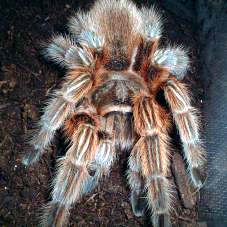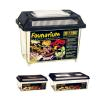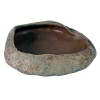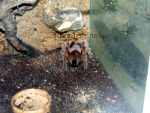Caring for Chilean Rose Tarantula - Grammostola rosea
Quick links - Answers
Brief Description
This page belongs to our "exotic pets series" articles which are not dedicated to fish, but to Grammostola rosea - Chilean Rose Tarantula! Feel free to share your experiences at the bottom of this page!
Introduction
Grammostola rosea is a species of tarantula that is extremely popular in the hobby of caring for this genus of spiders and they are relatively cheap to purchase compared to other species that are also available. We probably recognise this tarantula by its more common name of the Chilean Rose Tarantula but it is also known by other common names that you may come across such as the Chilean Flame Tarantula or the Chilean Fire Tarantula.
One of the reasons for the popularity of this spider is it’s extremely docile nature that allows the keeper to handle this species more than with the other more aggressive species and due to the ease of its care, this species of Tarantula is often the first choice for beginners to the hobby.
http://www.exotic-pets.co.uk/chile-rose-tarantula.html

Origin
Grammostola rosea originate from the desert regions of Chile which gives rise to their common name but they can also be found in similar regions of Argentina and Bolivia. They are a long lived pets,it is believed that a specimen can live for over twenty years but this has yet to be proven as this time period is the same as the period that these spiders have been kept as pets so present keepers will be able to confirm as their pets continue to survive. They are certainly not the largest of the Tarantula species, the average leg span is approximately 5 inches with a body length of 2.5 inches but they are a slow growing species and are very active, especially during the evening and night hours.
The body and legs are covered with hairs, these can be ejected when the spider feels threatened, when the Grammostola rosea are at a smaller size the hairs are a pinkish colouration but these will darken to a more reddish colouration as the tarantula matures.
Behaviour
Rather than being aggressive they tend to be more skittish and would prefer to run away from a threatening situation but if the odds are against them, they can still stand their ground and inflict a nasty bite to their foe. It has been mentioned above that this species of Tarantula are ideal for beginners to the hobby but they, like any other creature, still have needs that must be met so hopefully after reading this article you will get an insight as to what this hobby involves.
http://www.exotic-pets.co.uk/plastic-tanks-and-enclosures-for-sale.html

Housing Grammostola rosea correctly
Tarantulas can either be climbers or ground dwellers or even a combination of both. Grammostola rosea tend to be terrestrial and very rarely climb but they are capable of doing this if required, because of this the ground space inside the enclosure is important, they will need room to manoeuvre around but do not make the enclosure too large as this can sometimes unsettle your Tarantula. The actual enclosure can be an aquarium or plastic container, there are commercial enclosures available but whatever option you choose there must be a lid fitted with ventilation holes to allow for a good air flow but not allowing your Tarantula to escape.
http://www.exotic-pets.co.uk/peat-coco-and-humus-bedding-for-sale.html

The substrate is also important as these Tarantulas may burrow, not as often as other species but the substrate must be deep enough to allow for this. The choices for substrate can be peat, vermiculite, potting soil or coconut fibre.
If using peat or potting soil then this must be sterilised before use as it can harbour pests or even moulds and fungus spores. Sterilisation can be performed by placing the substrate into a microwave for a few seconds but it must be completely dried out first.
Vermiculite is a very popular choice as it doesn’t need to be sterilised before use and will hold the moisture well, it is also possible to use a mix of peat or potting soil with the vermiculite to create the perfect balance if required.
Coconut fibre usually is sold in blocks that expand when moisture is added, this allows for a smaller storage place and is also an excellent choice as it is relatively inexpensive.
Whichever substrate you decide on you must moisten it before placing it into the enclosure, never wet it through but just dampening will suffice. Once in place it can be kept moistened by dripping water down the sides of the enclosure, this also allows the top surface to become drier giving the spider a steady footing, the lower levels will remain damp thus helping with the humidity levels.
The substrate depth should be between 2-3 inches, with juvenile specimens 1 inch of substrate will suffice.
http://www.exotic-pets.co.uk/hides-and-caves-for-sale.html

A hide will need to be added to the enclosure so that your Tarantula can hide away if it wishes to do so, this may occur more often in the daylight hours as they tend to become more active during the evening and night time hours. There are commercial hides that can be purchased but as most of use have limited budgets there are other items that you can use for the same purpose. Many keepers will use a plant pot laid on its side and partially buried in the substrate, only the other day I saw an enclosure where someone had used the cores from paper towelling rolls, these were simply cut in half and coated in a non-toxic glue, the outer surface was applied very simply by dipping the glued section into some substrate so that the hide blended in with the décor. Plastic tubing can also be used just as effectively.
http://www.exotic-pets.co.uk/water-bowls-and-waterfalls-for-sale.html

Once the hide is in place you will need to add a water bowl or just recently tarantula sponges seem to be becoming very popular. The water dish needs to be stable and shallow, the water will need replacing every other day, daily is preferred. Using a sponge ensures that the Tarantula still has access to a moisture source but there is no danger of water being tipped into the enclosure and more importantly there is no risk of your Tarantula actually drowning in its own water bowl.
Plants can be added for an authentic look to the enclosure but use artificial or silk plants, this will remove any chance of rotting vegetation fouling the enclosure plus the artificial plants are a lot easier to keep clean, a simple wipe with a damp cloth will do the job.
The Chilean Rose Tarantula does not require extra heating unless you live in cooler climates, the recommended temperature range for these spiders is between 23-30 deg C (75-85 deg F) and the humidity level should be kept between 60%-70%, the use of a reliable thermometer added to the inside of the enclosure will enable you to monitor the temperature at all times. As you can see the temperature range is in the normal room temperature range and this should be allowed to drop a few degrees during the night-time hours. If your room temperature does drop below this range you can attach a heat mat to the rear of the enclosure, do not place the heat mat directly below or this can dry out the substrate and cause problems for your Tarantula. If the humidity drops then you can either drip some more water into the substrate or spray the inside of the enclosure.
Lighting is not an important aspect in the life of the Tarantula, they much prefer darker conditions but as keepers we do like to see our pets, artificial lighting can be used but do not add bright lighting. You can use a red or blue bulb, failing this a low wattage bulb will suffice but if using these try to replicate standard day and night time hours by the use of a timer. In the winter months less lighting hours will also replicate nature so bear this in mind.
Feeding the Chilean Rose Tarantulas
Tarantulas depend on the keeper to supply the correct diet for them, this is not too difficult as you will soon find out. The most common mistake that keepers can make is to overfeed their spider, it is natural for us to think that their pets are always hungry and pets can be clever to give us this impression, the more food we add to the enclosure, the more obese the spider will become, this is not helping them. Live foods are the most popular in the form of crickets or locusts etc. these only need to be fed twice a week to adult specimens, juvenile spiders require more regular meals but the size of the meals is smaller and the actual food given must be smaller, in many cases pin head crickets are used. If using crickets then a couple each meal for an adult specimen is fine, you may notice that every now and again their appetite may decrease, this could be just prior to an imminent moulting or just a natural fasting period that the spider is going through. Keep trying to offer the food unless your spider has just moulted, any uneaten food must be taken out off the enclosure after 24 hours.
It is best to gut load the food before feeding them to the Tarantula, this is quite easily performed by offering the crickets or locusts greens a few hours before feeding them to the spider, gut loading will provide extra nourishment for your Tarantula with the same amount of food.
Common problems encountered when caring for the Chilean Rose Tarantula
As mentioned above, the Chilean Rose Tarantula is the most common species kept and is recommended for novices to Tarantula keeping but there are common problems encountered with this species of spider.
Many new keepers may be disappointed by the lack of movement of the new Chilean Rose, unfortunately this is quite common, many specimens can be inactive and keepers may lose interest in them. You cannot overcome this as some specimens are just not born to be over-active. If your specimen is very active make sure that it cannot climb to the top of the enclosure and injure itself by falling back to the substrate, if the depth of substrate is deep enough to cushion and the enclosure is not too tall then this should never be a problem for you.
Moulting is always a critical time for nay spider, the new skin has to develop below the old skin prior to the moulting and once the moult is complete, your spider will be very soft and susceptible to injury, keeping live food in the enclosure at this time should never happen as the crickets etc. as they can actually attempt to feed off your spider.
The age of your spider, especially with wild caught specimens can be hard to determine. Often new keepers will purchase a spider for it to die a few months later unexpectedly despite all of their efforts to care for the pet properly, this is usually due to them living out their natural lifespan, nowadays most specimens are captive bred so the true age can be determined, if you are purchasing from a breeder or a reputable supplier, inquire as the age so that you know how long you can expect to keep your spider for.
Tarantula Moulting
Tarantulas can only grow by shedding their exo-skeleton and this is commonly referred to as moulting. In the wild the tarantula is at a higher risk from predators during this process, in captivity this risk is simply not there so the moulting process should pass with no problems. The first signs of a moult approaching are normally a loss of appetite, the tarantula may appear restless and also discard a lot of the hairs from the rear of its abdomen.
The tarantula will create a small web in the form of a cradle to rest on while moulting and often the tarantula will lie on its back during the moult , this can be a worrying time for the keepers but it is a natural position for the spider. Do not attempt to disturb the tarantula during this time as it will be stressed anyway and disturbing it will make matters worse. The abdomen should split first allowing the spider to slide out of its old skeleton, fluid pumped into the legs will cause these to split away and the spider will free itself in time. The moulting can be quite quick, a matter of minutes or it can take a few hours, you will soon find out that each moult will be different.
Once moulted the tarantula will have a soft body and definitely should not be handled at this stage, it can take several days for the skin to harden, the fangs will also be soft so eating is not an option until the drying out is fully complete.
Breeding the Chilean Rose Tarantula
Breeding this tarantula is not difficult but you do need to think carefully before undergoing this project, have you the facilities for raising the young and have you an outlet for moving on any juvenile spiders that you raise?
If you do feel that you can be successful and look after the young or move them on then the first stage of the breeding has to be sexing the tarantulas. The easiest way to sex the tarantula is to use a fresh moult. Carefully opening the abdomen area you will see 2 white areas on either side of the abdomen, above these and just below the joining of the abdomen to the carapace there is a central area that is known as the epigynal area. On the females there should be visible to the naked eye sacs that are used to store the sperm, these will not be present on a males moult.
Mature females tend to be larger and stockier than the males also, sexing is easier the more mature the specimen, with juveniles it can be very tricky. Males should also develop small hooks on their front legs, these are commonly referred to as “mating hooks”. Often the tarantula can be sexed incorrectly especially if you are new to this hobby, if in doubt seek help from an expert who know what they are looking for.
Mating takes place after a moult, as females tend to moult once a year the timing has to be spot on. The male will undergo his maturing moult where his physical appearance may change, his body will be smaller compared to his leg span and his legs may change to becoming longer and thinner. On the ends of his legs that are located near the mouth, bulbous ending will appear, these are where the sperm is stored ready for passing onto the female.
In the corner of the enclosure the male will create a hammock shaped web, this usually occurs within a couple of weeks after the mature moulting and this web is used during the mating process. Now you may find the male performing strange actions but he does have a reason for this, the male will climb underneath the web and start to rub itself against the web, he is now depositing sperm onto the web itself. The male will now climb onto the top of the web and walk all over it. He is now picking up the sperm and storing it in the sperm sacs at the end of its legs. Once stored the web will usually be dismantled and the male is now ready to mate with a suitable female of the same species.
Introducing the male to the female can be a tricky process if certain rules are not followed, it is not simply a matter of just placing them into the same enclosure. The male should be added into the females enclosure at the opposite end to where she is residing, never place the male directly next to the female. He will now start to perform to the female by drumming on the substrate and gently vibrating his abdomen, during this time he will creep closer to the female which is usually the worrying time for the keeper as the females are more than capable of killing the male spider. When he reaches the female he will rub her legs and at this time the female will go into a threatening mode raising her fangs. The male will lock her fangs with his mating hooks that were described above and lift the female to allow mating to take place.
Once mating is complete, the male is at its most dangerous position, he will very quickly release the fangs and move away from the female, at this stage the male should be removed from the enclosure for its own safety.
The female will now spend all of her time producing the egg sac and will need plenty of food to keep her strong. She will produce lots of webs and may burrow right up to the eggs being held. Once the egg sac has been produced do not offer any more feeds and definitely do not try to handle her, if she is startled or feels threatened, she will eat the egg sac.
Raising the spiderlings
The hatching time for the baby spiders varies a great deal with the shortest recorded time being 4 weeks after the egg sac has been produced, often it can take several weeks longer for the hatching to occur. The newly hatched spiders are known as “nymphs” and will be white in colour, they will not show any sign of colouration until their first moult. Spiderlings are cannibalistic so remember this when raising the young, It will be required to split the young into smaller groups as they develop.
On the longer term the spiderlings can be raised in very small plastic containers filled with a small amount of substrate that is kept moist but not wet. Individual spiderlings can even be housed in the small plastic cases that camera films are stored in.
The spiderlings can be fed on very small crickets or even maggots, every time that you feed them check for moults and remove these, the younger the spider the more rapid the moulting occurs as they do grow very quickly. They will require more feeds than adult specimens, twice a week should suffice.
As the spiderlings grow larger they will need to be re-homed into larger containers so make sure that you have these ready to create a new home for the young as required.
Please take note:-
Although the Chilean Rose Tarantula is not classed as highly venomous, their venom and even the hairs that cover their abdomen and legs can cause an allergic reaction to some people, handling should only be performed by experienced keepers and if you are unsure if you do have an allergy, never handle these creatures.
A fall to a tarantula is bad news, this is often the cause of mortalities to these creatures, if you do have to pick this spider aloft, never raise it too high above a safe surface just incase it does get dropped!
All pictures reproduced by permission of:-
(except for the first one) www.exotic-pets.co.uk

